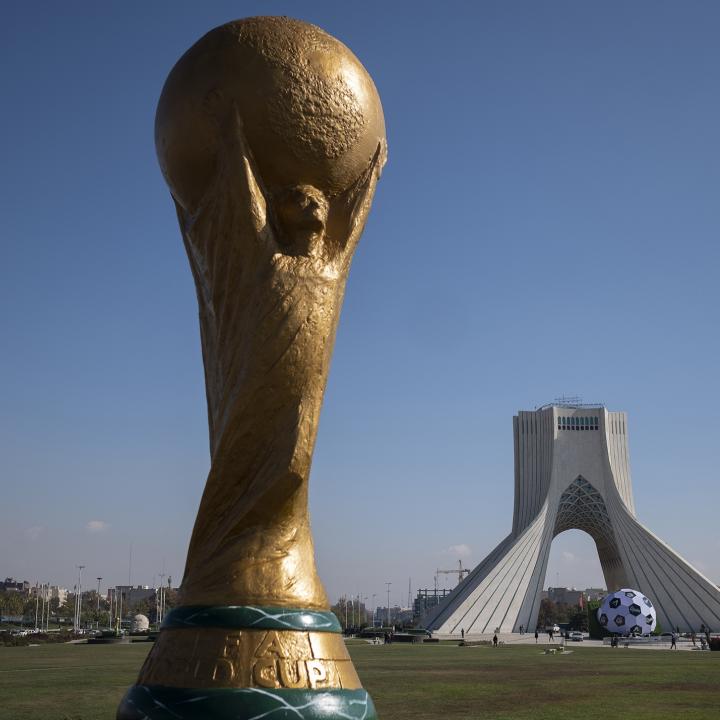

Instead of attracting tourists, boosting the economy, and rallying Iranians around the flag, this year’s tournament could turn into a Pyrrhic victory for the regime given its dire political situation at home.
On paper, the Qatar World Cup should be an occasion for much celebration and opportunity in Iran. After qualifying for three tournaments in a row, the talented squad representing this football-obsessed nation is looking to pass the initial group stage for the first time ever. The fact that the matches will be held in Iran’s backyard likely convinced the regime that it could simultaneously attract tourists and boost the economy via joint projects with Doha. Yet weeks of mass protests have drastically changed Tehran’s plans on this front.
In April, Vice President Mohammad Mokhber reviewed seventy areas of potential economic cooperation during the tournament, such as hosting fans on Iran’s Persian Gulf islands and ferrying tourists back and forth to Qatar. More recently, however, the economic newspaper Donya-e-Eqtesad reported that “none of the promises made by Iranian officials have materialized,” while the reformist paper Etemad noted that 20,000 Iranian hotel rooms set aside for football tourists remained empty—a situation no doubt exacerbated by the regime’s high-profile detainment of foreigners amid the protests.
In the past, sports helped Iran’s leaders marshal some degree of nationalistic unity despite simmering public discontent. Yet the uprising has led many current and former athletes to align with the protesters. Football legends such as Ali Karimi and Ali Daei supported the demonstrations from the very beginning and recently turned down invitations to attend the World Cup. In response, hardliners have publicly threatened their assets and even their lives. Last month, Javan—a newspaper affiliated with the Islamic Revolutionary Guard Corps (IRGC)—warned Daei that “whoever doesn’t know his limits will perish,” while Karimi was charged in absentia for “acting against national security.”
In another show of solidarity, the national teams for various sports have remained silent when the Islamic Republic’s anthem played during recent competitions, including basketball, water polo, and even the football squad during last week’s friendly against Nicaragua. On November 15, Coach Carlos Queiroz told reporters that his players can protest if they want so long as they respect the rules and spirit of the World Cup; two days later, top players Alireza Jahanbakhsh and Alireza Beiranvand said that singing the anthem and celebrating goals are personal decisions for each teammate. The issue has received prominent media attention, and activists are reportedly planning to protest inside and outside Iran’s matches, making the regime extra sensitive to any symbolic support from the team. One former parliamentarian warned this week that players who do not sing the anthem or celebrate goals may be removed. The regime has also reportedly sought to control in-game Persian media coverage by convincing Qatar to ban at least one network sympathetic to the protesters (the London-based Iran International).
Interestingly, in mobilizing public support against the demonstrations, the regime has focused on nationalist rather than religious themes. Many recent murals in Tehran’s famous Valiasr Square feature a spectrum of national symbols and ethnic groups, aiming to rally the people around a patriotic ethos and urging them to keep Iran from “falling into the enemy’s hands.” One mural featured the unofficial national anthem “Ey Iran,” which was first published during the Pahlavi monarchy.
The regime is using the football team for similar purposes. On November 13, it unveiled a mural showing players accompanied by ancient and pre-Islamic heroes. The squad has also occupied the front pages of most major newspapers all week. When they met with President Ebrahim Raisi, the encounter was headlined “For the Iranian Flag,” and Raisi was given an honorary “Twelfth Player” jersey. Yet efforts to celebrate the team and lighten the atmosphere have rankled many young Iranians, with activists criticizing the squad for posting playful photos while other youths are being beaten and killed across the country.
As for the competition itself, Iran’s initial four-team round-robin group notably includes the United States, England, and Wales, with only the top two squads advancing to the tournament’s knockout stages. Its first match is against England on November 21, followed by Wales on November 25 and the United States on November 29.
The latter match holds especially potent political implications. The two countries famously squared off at the 1998 World Cup in France, with Iran’s victory sparking days of nationwide festivals back home. Minutes after the match, Supreme Leader Ali Khamenei congratulated the nation on defeating its “arrogant” opponents, comparing the game with “past victories” against “the Great Satan.”
Today’s context is even more ripe for nationalist exploitation and anti-American sentiment. In truth, the 1998 match was a rather friendly encounter on the field, with new reformist president Mohammad Khatami using football diplomacy to foster wider bilateral rapprochement. Players followed the World Cup custom of exchanging jerseys after the win and posed for a joint pregame photo. Yet Raisi is not Khatami, and current relations are far from detente. The regime is more eager than ever to rally Iranians around the “football flag” with a win against the United States, both to serve its propaganda aims and to counter any further momentum the protests may gain during the tournament.
This may be easier said than done, however. In April, Raisi’s spokesman jokingly tweeted that football star Sardar Azmoun should meet with the IRGC air force chief to brainstorm ahead of the U.S. match, playing off the fact that “Sardar” can be translated as “General.” By September, however, Azmoun had posted his support for the protests on Instagram. He deleted the post a few hours later and was ultimately included on the national roster, but the incident highlighted the precarious state of Tehran’s profit-risk balance at Qatar 2022.
Omer Carmi is a former visiting fellow at The Washington Institute.


